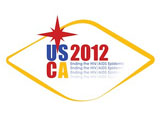U.S. Conference on AIDS – Highlights from Day 2
Topics

The annual U.S. Conference on AIDS (USCA) continued Monday. Among the highlights was a plenary session that put the spotlight on research for an HIV cure.Advances in HIV Cure Research

Dr. Jack Whitescarver. Photo credit: Ben Carter/NMACThe presentation, “Toward a Cure for HIV: The Need for Science, Collaboration, and Advocacy”, was moderated by Dr. Jack Whitescarver from the Burnet Institute Center for Virology in Melbourne, Australia.
Dr. Whitescarver began his remarks reflecting on how essential the collaboration between the HIV community and researchers has been on numerous scientific fronts including planning and designing clinical trials, translating research findings to clinical settings, and developing and updating treatment guidelines. This collaboration has brought about major advances in HIV treatment and prevention over the decades, serving as a model for other diseases, he noted. The community-research collaboration continues to inform NIH research in such areas as the side effects of long term HIV treatment, premature aging, and cardiovascular complications experienced by people living with HIV as well as examinations of treatment outcomes by sex, race, gender, age, and pregnancy status. Recent years have also brought advances in therapeutics research and the scientific understanding of how HIV establishes itself, hides in the body, and remains latent. These findings have been critical precursors to enabling researchers to start to talk about developing a strategy toward an HIV cure. Dr. Whitescarver pointed out that this high priority area is now a key section in the FY 2013 Trans-NIH Plan for HIV-Related Research. Continued collaboration with the HIV community will be vital to the advancement of this research, he concluded.

Dr. Lewin, a world-renowned researcher, discussed recent advances, persistent complexities, and future opportunities in HIV cure science. Observing that recent advances in HIV prevention and treatment are fueling discussions about the end of AIDS, she noted that even if new HIV infections ceased today, there would still be more than 33 million people in the world living with HIV who needed lifelong access to treatment unless a cure is also found. Dr. Lewin discussed advances in understanding the latency of HIV in infected T cells, residual replication, and anatomical reservoirs that will be central to finding a cure. Dr. Lewin distinguished sterilizing and functional cures and their implications for combination strategies, investment in drug development, and understanding of immunological control of low-level viremia. She noted that numerous related studies are underway around the world, several supported by the NIH. As a result of these studies and the new Global Scientific Strategy Towards an HIV CureExit Disclaimer (PDF), Dr. Lewin anticipates new HIV cure-related discoveries will be shared at the 2014 International AIDS Conference.
Tomorrow, we’ll share highlights of some of Tuesday’s key messages from USCA.